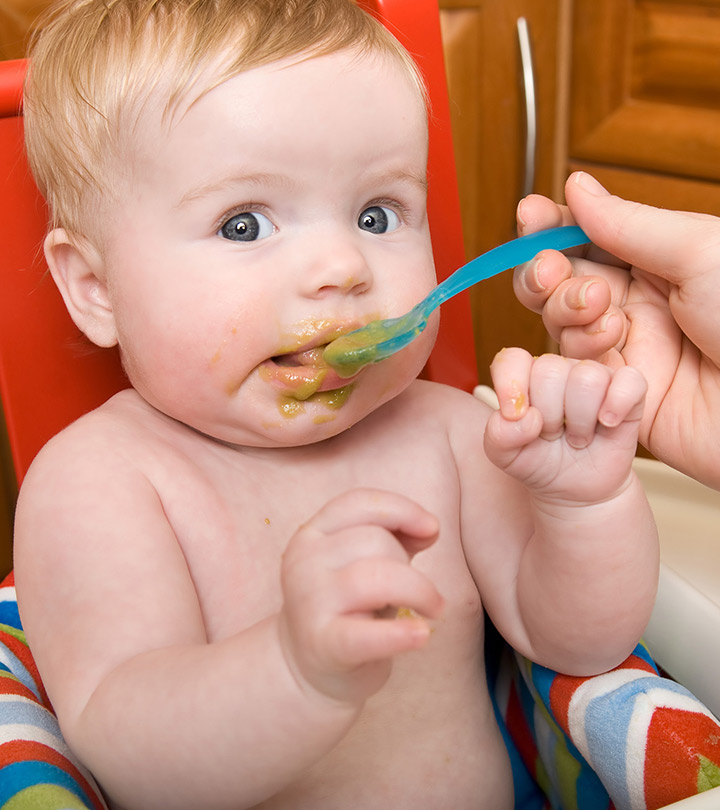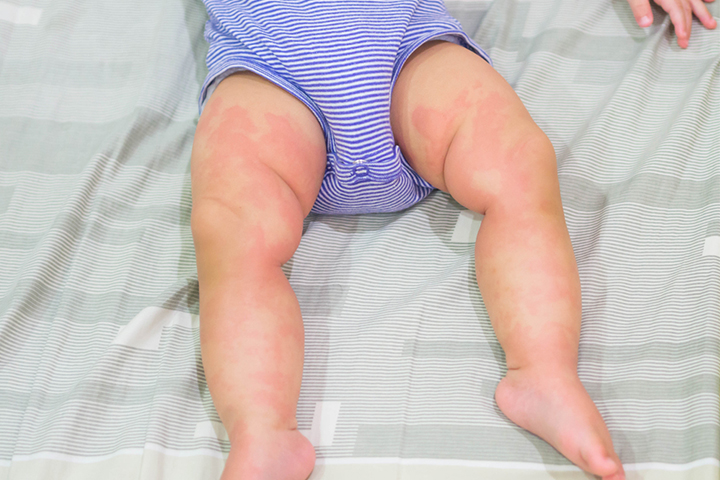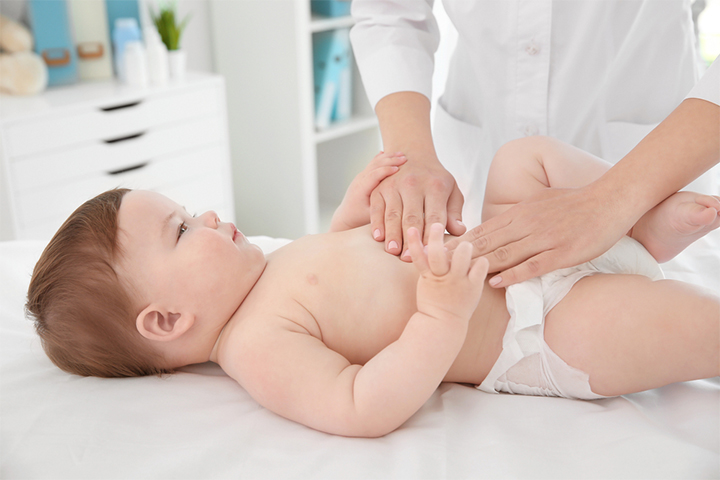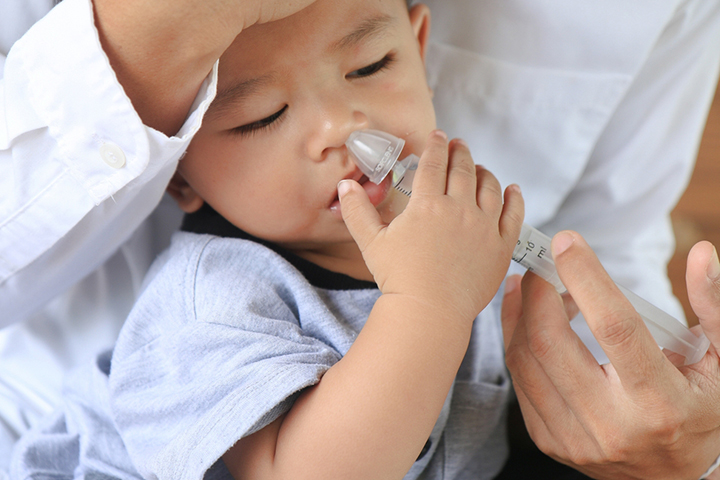Pea (Pisum sativum) is a nutrient-rich food with several varieties; yellow and green peas are the most commonly consumed. So, if you plan to feed peas to your baby, here’s all you need to know about pea allergy in babies to help you stay informed. Generally, allergies towards peas are uncommon, but the cross-reactivityiXA phenomenon where an antibody directed towards a specific antigen is recognized by different antigens. between peas and peanuts or other legumes like beans and lentils can occur. So, keep reading to know in detail about pea allergy, its symptoms, diagnosis, and effective treatment for babies.
Can Babies Be Allergic To Peas?
According to the Centres for Disease Control and Prevention (CDC), 5.8% of all children have a food allergy. Babies can be allergic to peas, especially if they have shown symptoms of allergy or food intolerance for other legumes. Legumes are a family of foods that includes peas, peanuts, beans, and lentils (1).
A research study published in the Journal of American Academy of Pediatrics showed that a high degree of cross-reactivity existed between lentils, chickpea, and peas (2). Besides, pea allergy can also occur due to the Immunoglobulin E (IgE)-mediated (antibody-mediated) cross-reactivity between peas and peanuts (3).
There is a chance for a baby to outgrow pea allergy over a period. But it is good to consult a doctor before introducing peas to a baby and always follow three-day pattern when you introduce pea or any new food into the weaningiXThe process of transforming your baby’s diet from breastmilk to solids and other liquids. diet
What Are The Symptoms Of Pea Allergy In Babies?
The symptoms of pea allergy vary among babies. For some, the symptoms could be mild, while for others, they could be serious. Below is the list of mild symptoms of pea allergen exposure (1)(4).
- Bumps on the skin called skin hives on any part of the body. Severe cases could cause eczema, urticariaiXA skin rash characterized by itchy bumps, often triggered by certain foods or medications.and nettle rashiXRound red bumps on the skin usually caused by an allergic reaction to specific foods.
- Tingling or itchiness in the mouth, throat, lips, or entire face
- Stomach cramps or intestinal discomfort
- Vomiting and cough
Severe symptoms could be as follows:
- Wheezing
- Difficulty breathing,asthma (it can worsen if already present), and increased heart rate
- Anaphylaxis, which can cause the sensation of choking and severe difficulty in breathing
It is best to seek medical assistance irrespective of mild or serious symptoms of allergy or food sensitivity. Timely action could avoid complications, and also help in diagnosis.
How Is Pea Allergy In Babies Diagnosed?
Below are some diagnosis methods that are likely to be used by the doctor (5).
- Personal and medical history: The healthcare provided will ask about the baby’s past allergy episodes if any. The details of food allergies experienced by other family members will also be noted.
- Physical exam: The baby’s ears, eyes, nose, throat, chest, and skin will be examined. An exam of lung function and X-ray of lungs or sinuses could also be done.
- Food elimination test: The parents will be instructed to eliminate suspected food items from the baby’s diet. You will need to eliminate the food for the duration instructed by the doctor.
A skin prick test can provide an accurate diagnosis of suspected allergen, but the test might not be performed on infants due to the risk of causing a severe allergic reaction.
If the diagnostic steps consistently raise suspicion towards peas in the baby’s diet, then a pea allergy is confirmed.
How To Manage Pea Allergy In Babies?
The management of pea allergy involves reducing the intensity of the symptoms. Below are some medicines that can help provide relief from the symptoms of pea allergy (6).
- Use a saline rinse: If your baby is suffering from nasal congestion due to allergic reaction, then a nasal saline rinse might provide some relief. Consult the doctor to learn the right type and dosage of saline drops.
- Corticosteroid creams or ointments: CorticosteroidsiXSteroid hormones produced in the adrenal cortex that help alleviate inflammation and the immune system activity., also known as steroids or cortisone, are highly effective for allergy treatment. These are used topically for relief from hives, nettle rash, and urticaria.
- Antihistamines: This class of medication can help calm sneezing, itching, runny nose, and hives.
- Nasal corticosteroids: These nose sprays are used to relieve nasal allergies. They generally provide relief against the swelling caused by the persistent runny and itchy nose.
- Decongestants: It can help provide relief from severe congestion of the nose and airways due to an allergic reaction. A decongestant is often administered in combination with an antihistamine.
Never give any allergy medicine to the baby without a doctor’s recommendation. The doctor will suggest the medicines after taking into consideration the baby’s age, the severity of the symptoms, and general health. In severe cases of allergy, the doctor might suggest extensive treatment methods such as immunotherapyiXTreatment modality that uses the body’s immune system to fight diseases, used most notably for treating cancers. (7).
Treatment will provide relief to your baby. However, precautions will help prevent a recurrence.
How To Prevent Pea Allergy In Babies?
The following precautionary measures can help the baby avoid the symptoms of pea allergy (7)(8).
- Avoid allergen:If possible, avoid giving peas to the baby. You can replace peas with other legumes to which the baby is not allergic. Speak to a pediatric nutritionist to determine the bests food to replace peas in the baby’s diet.
- Check labels: Peas can be a part of many ready-to-feed baby foods. If you are feeding any packaged food to your baby, check for the labels.
- Try to carry baby’s meals: If you are traveling or stopping by at someone’s place, then it is best to prepare and carry the baby’s meals. It will help you ensure the baby’s food does not have peas and reduce the risk of hypersensitivity reactions.
Because babies are still unfamiliar with different food groups and their immunity is not as robust as adults, it is common for them to be allergic to certain foods. Be mindful of their reactions in order to recognize the allergy and switch to different foods while taking the necessary precautions to avoid contact with any potential allergens. Likewise, pea allergy in babies can be managed as long as you are aware of the symptoms and seek timely treatment.
Key Pointers
- The protein Pis s 1 (Vicilin) in peas is the primary allergen associated with pea allergy.
- Babies can develop a pea allergy due to cross-reactivity with other legumes like peanuts, lentils, and beans.
- Symptoms of pea allergy include skin hives, stomach cramps, tingling in the mouth, anaphylaxis, and wheezing.
- Antihistamines, corticosteroid creams, decongestants, saline rinses, and nasal corticosteroids are treatments available for pea allergy.
- It is crucial to never give allergy medication to a baby without a doctor’s approval.














